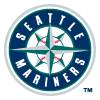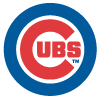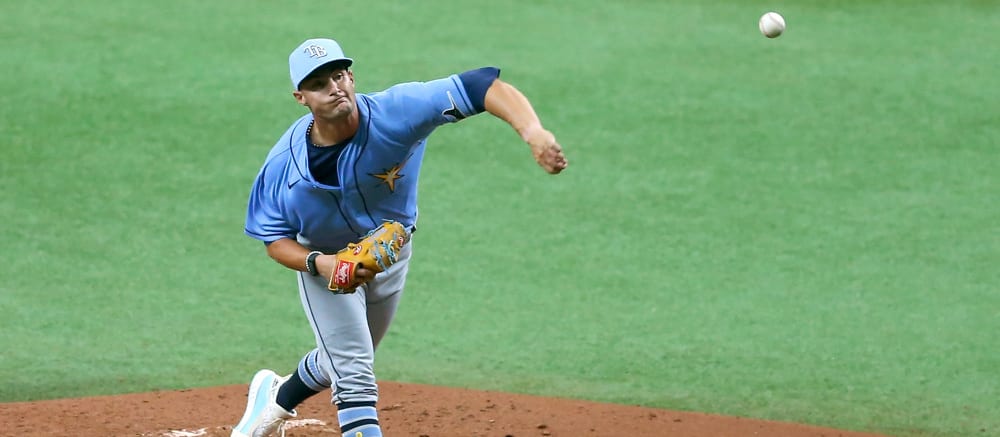This article is part of our MLB Barometer series.
Six weeks. That's all that's left of the regular season. It's not a lot of time, and many deficits at this point are insurmountable. (If that applies to your team and you're still here reading fantasy baseball articles, thanks for reading.) That's especially true in leagues that have playoffs, which could begin in as little as two weeks, meaning those deficits may have become too big to overcome a few weeks ago.
A lot can still happen over a six-week time period, however. The following things were true six weeks into this season (on May 13):
- Tampa Bay and Atlanta were both fourth in their respective divisions. Both now lead their divisions by at least 4.5 games.
- Yermin Mercedes led the league in batting average and was the third-best hitter by wRC+ with a mark of 180, hitting .382/.424/.591. He's hit .177/.250/.246 since then, good for a 42 wRC+, and has been in the minors since the end of June.
- Robbie Grossman was tied for third with seven steals. He has eight since, tying him for 28th.
- Luis Castillo was last among qualified starters with a 7.71 ERA. He owns a 3.19 ERA since then.
- John Means and Matthew Boyd had ERAs south of 2.00. Both have ERA north of 5.50 since that point.
- Cesar Valdez was tied for sixth with eight saves. He hasn't recorded a save since then and was recently designated for assignment.
The six weeks of the season don't always look like the rest of the
Six weeks. That's all that's left of the regular season. It's not a lot of time, and many deficits at this point are insurmountable. (If that applies to your team and you're still here reading fantasy baseball articles, thanks for reading.) That's especially true in leagues that have playoffs, which could begin in as little as two weeks, meaning those deficits may have become too big to overcome a few weeks ago.
A lot can still happen over a six-week time period, however. The following things were true six weeks into this season (on May 13):
- Tampa Bay and Atlanta were both fourth in their respective divisions. Both now lead their divisions by at least 4.5 games.
- Yermin Mercedes led the league in batting average and was the third-best hitter by wRC+ with a mark of 180, hitting .382/.424/.591. He's hit .177/.250/.246 since then, good for a 42 wRC+, and has been in the minors since the end of June.
- Robbie Grossman was tied for third with seven steals. He has eight since, tying him for 28th.
- Luis Castillo was last among qualified starters with a 7.71 ERA. He owns a 3.19 ERA since then.
- John Means and Matthew Boyd had ERAs south of 2.00. Both have ERA north of 5.50 since that point.
- Cesar Valdez was tied for sixth with eight saves. He hasn't recorded a save since then and was recently designated for assignment.
The six weeks of the season don't always look like the rest of the year, and the last six can get even weirder. The spread in overall talent level between the best and worst clubs is never larger than it is late in the year, due to a mix of deadline moves, the buildup of injuries and late-season call-ups. Here are some things that happened in the last six weeks of the 2019 season (I skipped over 2020, as last year's shortened schedule lasted just over nine weeks):
- Anthony DeSclafani was fifth among qualified starters with a 0.80 WHIP. Mike Foltynewicz was seventh with a WHIP of 0.84.
- Foltynewicz was fourth in ERA (1.73), while Dakota Hudson was eighth (2.09).
- Hudson and Jordan Lyles were among those tied for fourth with five wins.
- Trevor Bauer was second-worst among qualified starters with a 6.02 ERA. Noah Syndergaard was fifth-worst at 5.77.
- Tommy Edman, Ji-Man Choi and Jurickson Profar were all top-20 hitters by wRC+.
- Brett Gardner and Starlin Castro were among those tied for ninth with 11 homers.
- Jon Berti, who had six career steals up to that point, swiped 12 bags, tying him for the league lead over that stretch.
- Asdrubal Cabrera led the league with 35 RBI.
Hopefully those small-sample oddities demonstrate that things can break in all sorts of ways over a six-week stretch. As long as you're vaguely close to first place (or to the final spot in the money, or whatever else your target goal is), don't despair. The next Foltynewicz, Profar or Berti may still be out there, potentially among the names listed below.
RISERS
 Freddie Freeman, 1B, Atlanta: Freeman is on an incredible tear over his last eight games, grabbing at least one hit in all eight while slashing .471/.538/.882 with three homers and just four strikeouts. That hot streak is really part of a longer surge, which dates back to mid-June, as he hit a modest .224/.349/.435 through June 9 but has hit .364/.438/.587 since then. The improvement looks more like Freeman's results improving to match his peripherals than a real change in his underlying numbers, however. It's not hard to make the case that he was doing everything right even in the early part of the season. His walk rate (15.3 percent) nearly matched his strikeout rate (17.6 percent) over that stretch, while his 50.3 percent hard-hit rate and 11.8 percent barrel rate through June 9 are both actually slightly higher than his marks since then (45.7 percent and 11.5 percent, respectively). Freeman was unlucky over the early stretch, as seen in his .224 BABIP, and he's seemingly been somewhat lucky over the latter, posting a .392 BABIP. While that may mean he won't remain quite this hot down the stretch, there's every reason to believe the veteran first baseman will remain his usual elite self going forward.
Freddie Freeman, 1B, Atlanta: Freeman is on an incredible tear over his last eight games, grabbing at least one hit in all eight while slashing .471/.538/.882 with three homers and just four strikeouts. That hot streak is really part of a longer surge, which dates back to mid-June, as he hit a modest .224/.349/.435 through June 9 but has hit .364/.438/.587 since then. The improvement looks more like Freeman's results improving to match his peripherals than a real change in his underlying numbers, however. It's not hard to make the case that he was doing everything right even in the early part of the season. His walk rate (15.3 percent) nearly matched his strikeout rate (17.6 percent) over that stretch, while his 50.3 percent hard-hit rate and 11.8 percent barrel rate through June 9 are both actually slightly higher than his marks since then (45.7 percent and 11.5 percent, respectively). Freeman was unlucky over the early stretch, as seen in his .224 BABIP, and he's seemingly been somewhat lucky over the latter, posting a .392 BABIP. While that may mean he won't remain quite this hot down the stretch, there's every reason to believe the veteran first baseman will remain his usual elite self going forward.
 Ty France, 1B/2B, Mariners: France occupied a strange space heading into the season, one in which players can sometimes wind up significantly undervalued, as he clearly had at least something to his game but didn't exactly stand out in any one way. Heading into his age-26 season, he certainly wasn't old, but he was no longer young, either. He'd shown some contact but not a ton, striking out 24.2 percent of the time, as well as some power but not enough to write home about, hitting 11 homers in 356 plate appearances. He also didn't really have a position but wasn't totally positionless, spending most of his time at the infield corners but also making a fair number of starts at second base. France was only making himself more forgettable early in the season, hitting .246/.340/.357 with just three homers through June 13, but he's since turned things around dramatically. From June 14 onward, he's hit .335/.383/.558 with 12 homers. A .356 BABIP has seemingly inflated that line at least a bit, but he's also striking out just 15.7 percent of the time, so he should be able to maintain a good batting average to go along with decent power. He's shown plenty of that power in recent days, homering three times in his last four games.
Ty France, 1B/2B, Mariners: France occupied a strange space heading into the season, one in which players can sometimes wind up significantly undervalued, as he clearly had at least something to his game but didn't exactly stand out in any one way. Heading into his age-26 season, he certainly wasn't old, but he was no longer young, either. He'd shown some contact but not a ton, striking out 24.2 percent of the time, as well as some power but not enough to write home about, hitting 11 homers in 356 plate appearances. He also didn't really have a position but wasn't totally positionless, spending most of his time at the infield corners but also making a fair number of starts at second base. France was only making himself more forgettable early in the season, hitting .246/.340/.357 with just three homers through June 13, but he's since turned things around dramatically. From June 14 onward, he's hit .335/.383/.558 with 12 homers. A .356 BABIP has seemingly inflated that line at least a bit, but he's also striking out just 15.7 percent of the time, so he should be able to maintain a good batting average to go along with decent power. He's shown plenty of that power in recent days, homering three times in his last four games.
 Shane McClanahan, SP, Rays: McClanahan showed a fair amount of promise after his late-April call-up but looked far from a finished product early on, posting a mediocre 4.42 ERA over his first nine starts. A particular worry from a fantasy perspective is that he'd topped out at 5.1 innings over that stretch and came up short of the five innings necessary to record a win five times. That now looks like simply an attempt by the Rays to manage his workload rather than any inherent inability to pitch deep into games, however, as he's managed at least five innings in nine of his last 10 starts, lasting at least six frames in half of those. He's been excellent over that stretch, cruising to a well-deserved 3.07 ERA. The young lefty's underlying numbers look strong across the board, as he's been better than average in all three of strikeout rate (28.5 percent), walk rate (7.8 percent) and groundball rate (45.8 percent) over the course of the season. Among pitchers who have thrown at least 90 innings this season, only Corbin Burnes, Clayton Kershaw and Zack Wheeler beat him on all three marks.
Shane McClanahan, SP, Rays: McClanahan showed a fair amount of promise after his late-April call-up but looked far from a finished product early on, posting a mediocre 4.42 ERA over his first nine starts. A particular worry from a fantasy perspective is that he'd topped out at 5.1 innings over that stretch and came up short of the five innings necessary to record a win five times. That now looks like simply an attempt by the Rays to manage his workload rather than any inherent inability to pitch deep into games, however, as he's managed at least five innings in nine of his last 10 starts, lasting at least six frames in half of those. He's been excellent over that stretch, cruising to a well-deserved 3.07 ERA. The young lefty's underlying numbers look strong across the board, as he's been better than average in all three of strikeout rate (28.5 percent), walk rate (7.8 percent) and groundball rate (45.8 percent) over the course of the season. Among pitchers who have thrown at least 90 innings this season, only Corbin Burnes, Clayton Kershaw and Zack Wheeler beat him on all three marks.
 Cal Quantrill, SP, Cleveland: Quantrill earned a bit of sleeper buzz during draft season on the back of his 2.25 ERA in 32 innings as a swingman last season, but an awful spring in which he struggled to an 8.78 ERA meant he failed to earn his expected spot in the starting rotation. He was a reliever for most of the first half and entered the break with an unremarkable 4.23 ERA across eight starts and 18 relief appearances. That number looked well-deserved, as he struck out just 16.0 percent of opposing batters and generated a below-average 39.0 percent groundball rate. Suddenly, he's emerged as one of the best starters in the league thus far in the second half, at least when judging by his 1.50 ERA. While he isn't going to maintain a number quite that good down the stretch, it does come with significant improvements in his peripherals, with his strikeout rate jumping to 24.2 percent and his groundball rate soaring to 53.7 percent. It's been only eight starts, but the improvement looks very legitimate, so expect the hype to be there again for the 2016 eighth-overall pick during next year's drafts.
Cal Quantrill, SP, Cleveland: Quantrill earned a bit of sleeper buzz during draft season on the back of his 2.25 ERA in 32 innings as a swingman last season, but an awful spring in which he struggled to an 8.78 ERA meant he failed to earn his expected spot in the starting rotation. He was a reliever for most of the first half and entered the break with an unremarkable 4.23 ERA across eight starts and 18 relief appearances. That number looked well-deserved, as he struck out just 16.0 percent of opposing batters and generated a below-average 39.0 percent groundball rate. Suddenly, he's emerged as one of the best starters in the league thus far in the second half, at least when judging by his 1.50 ERA. While he isn't going to maintain a number quite that good down the stretch, it does come with significant improvements in his peripherals, with his strikeout rate jumping to 24.2 percent and his groundball rate soaring to 53.7 percent. It's been only eight starts, but the improvement looks very legitimate, so expect the hype to be there again for the 2016 eighth-overall pick during next year's drafts.
 Frank Schwindel, 1B, Cubs: The Cubs blew up their roster at the deadline and don't yet have a wave of high-potential young players ready to go, leaving space for unheralded 29-year-olds like Schwindel to stake a claim to regular at-bats. Schwindel has certainly done everything he could to prove he's a legitimate major-leaguer, slashing .362/.413/.652 with four homers in 75 plate appearances as a Cub. It's a tiny sample, and he had a total of just 35 thoroughly unimpressive trips to the plate at the MLB level prior to joining Chicago, but there's reason to believe it's at least somewhat real. His Cubs line is clearly inflated by a .404 BABIP, but he's also striking out just 17.3 percent of the time, a very low mark for someone who does seem to have real power. In 334 career games at the Triple-A level, he's hit .297/.334/.523 with 68 homers and a 15.4 percent strikeout rate. Schwindel may be little more than a Quad-A player, but he's a Quad-A guy with an everyday role right now, and his long track record in the minors of making far more contact than the typical player in that category means he's more interesting than you might at first suspect.
Frank Schwindel, 1B, Cubs: The Cubs blew up their roster at the deadline and don't yet have a wave of high-potential young players ready to go, leaving space for unheralded 29-year-olds like Schwindel to stake a claim to regular at-bats. Schwindel has certainly done everything he could to prove he's a legitimate major-leaguer, slashing .362/.413/.652 with four homers in 75 plate appearances as a Cub. It's a tiny sample, and he had a total of just 35 thoroughly unimpressive trips to the plate at the MLB level prior to joining Chicago, but there's reason to believe it's at least somewhat real. His Cubs line is clearly inflated by a .404 BABIP, but he's also striking out just 17.3 percent of the time, a very low mark for someone who does seem to have real power. In 334 career games at the Triple-A level, he's hit .297/.334/.523 with 68 homers and a 15.4 percent strikeout rate. Schwindel may be little more than a Quad-A player, but he's a Quad-A guy with an everyday role right now, and his long track record in the minors of making far more contact than the typical player in that category means he's more interesting than you might at first suspect.
 Reynaldo Lopez, SP, White Sox: This one is unfortunately more of a name for the future, as Lopez was merely filling in for Carlos Rodon, who could return from a shoulder injury later this week, but Lopez deserves a mention for dragging himself back from irrelevancy and looking like a potential major-league pitcher for the first time in a long time. Being completely out on Lopez heading into this year was a very reasonable position, as he owned a 4.77 career ERA and a 5.52 mark over the last two seasons. The White Sox themselves were seemingly out on him as well, as he stayed in the minors for the entirety of the first half. He was called up at the break, pitching mostly in relief before making three starts in place of Rodon, and he's been surprisingly good, cruising to a 1.86 ERA in 29 innings, a number that comes with a 28.0 percent strikeout rate and 6.5 percent walk rate. There's reason to believe the improvement is somewhat sustainable (albeit not at the sub-2.00 ERA level), as he underwent surgery to correct blurred vision in May and says he now pitches with more confidence because he knows what pitch the catcher is calling. His appeal is limited to very deep leagues if he's back in a long-relief role, but he's suddenly a name to keep in mind for next year if he finds himself in the rotation.
Reynaldo Lopez, SP, White Sox: This one is unfortunately more of a name for the future, as Lopez was merely filling in for Carlos Rodon, who could return from a shoulder injury later this week, but Lopez deserves a mention for dragging himself back from irrelevancy and looking like a potential major-league pitcher for the first time in a long time. Being completely out on Lopez heading into this year was a very reasonable position, as he owned a 4.77 career ERA and a 5.52 mark over the last two seasons. The White Sox themselves were seemingly out on him as well, as he stayed in the minors for the entirety of the first half. He was called up at the break, pitching mostly in relief before making three starts in place of Rodon, and he's been surprisingly good, cruising to a 1.86 ERA in 29 innings, a number that comes with a 28.0 percent strikeout rate and 6.5 percent walk rate. There's reason to believe the improvement is somewhat sustainable (albeit not at the sub-2.00 ERA level), as he underwent surgery to correct blurred vision in May and says he now pitches with more confidence because he knows what pitch the catcher is calling. His appeal is limited to very deep leagues if he's back in a long-relief role, but he's suddenly a name to keep in mind for next year if he finds himself in the rotation.
FALLERS
 Ke'Bryan Hayes, 3B, Pirates: Hayes had plenty of fans heading into the year, as he flashed his talent in a 24-game sample last season, hitting .376 with 24 homers. His .450 BABIP was clearly unsustainable, but he could fall a fair amount and still be quite interesting. He had the prospect pedigree that suggested he was the real deal and the defensive prowess to keep him in the lineup even through cold stretches at the plate. It just hasn't been his year, unfortunately. He hit the 60-day injured list with a wrist injury after just two games, and while he hit a solid .304/.382/.456 in his first 21 games back in action in June, things have fallen apart since then. Since June 28, he's hit .224/.280/.316 with just two homers in 47 games. He's really struggled to make contact over his last 12 games, striking out 32.7 percent of the time. His defense has indeed kept him in an everyday role, but there aren't many runs or RBI to go around in a lineup as weak as the Pirates', as he's recorded just 31 and 27, respectively, in his 70 games this season.
Ke'Bryan Hayes, 3B, Pirates: Hayes had plenty of fans heading into the year, as he flashed his talent in a 24-game sample last season, hitting .376 with 24 homers. His .450 BABIP was clearly unsustainable, but he could fall a fair amount and still be quite interesting. He had the prospect pedigree that suggested he was the real deal and the defensive prowess to keep him in the lineup even through cold stretches at the plate. It just hasn't been his year, unfortunately. He hit the 60-day injured list with a wrist injury after just two games, and while he hit a solid .304/.382/.456 in his first 21 games back in action in June, things have fallen apart since then. Since June 28, he's hit .224/.280/.316 with just two homers in 47 games. He's really struggled to make contact over his last 12 games, striking out 32.7 percent of the time. His defense has indeed kept him in an everyday role, but there aren't many runs or RBI to go around in a lineup as weak as the Pirates', as he's recorded just 31 and 27, respectively, in his 70 games this season.
 Jared Walsh, 1B/OF, Angels: I liked Walsh quite a bit heading into the season based on his sudden breakout over a 32-game sample last year, as he combined tons of contact (striking out just 13.9 percent of the time) with tons of power (.354 ISO). Through his first 47 games this year, I was thrilled to have him, as he cruised to a .321/.385/.583 line with 11 homers, with his strikeout rate rising considerably but still sitting at a very palatable 24.1 percent. Things went downhill fast over his next 50 games before he suffered an intercostal strain in late July, however, as his strikeout rate jumped to 30.9 percent while his slash line cratered to .219/.261/.459. He's been back from the injured list for 12 games now, and things have only gotten worse, as he's yet to homer over that stretch while hitting .225/.354/.250 with a 31.3 percent strikeout rate. Walsh's cold streak is nearly as long as his hot streak, which is quite worrisome for a player who didn't have all that much pedigree prior to his small-sample success last season.
Jared Walsh, 1B/OF, Angels: I liked Walsh quite a bit heading into the season based on his sudden breakout over a 32-game sample last year, as he combined tons of contact (striking out just 13.9 percent of the time) with tons of power (.354 ISO). Through his first 47 games this year, I was thrilled to have him, as he cruised to a .321/.385/.583 line with 11 homers, with his strikeout rate rising considerably but still sitting at a very palatable 24.1 percent. Things went downhill fast over his next 50 games before he suffered an intercostal strain in late July, however, as his strikeout rate jumped to 30.9 percent while his slash line cratered to .219/.261/.459. He's been back from the injured list for 12 games now, and things have only gotten worse, as he's yet to homer over that stretch while hitting .225/.354/.250 with a 31.3 percent strikeout rate. Walsh's cold streak is nearly as long as his hot streak, which is quite worrisome for a player who didn't have all that much pedigree prior to his small-sample success last season.
 Yusei Kikuchi, SP, Mariners: Kikuchi deserved far better than his 5.17 ERA in last year's shortened season, with his xERA (3.40), FIP (3.30) and xFIP (3.78) all suggesting that he got extremely unlucky. Through his first 15 starts of this season, he did indeed fare far better, as he cruised to a 3.18 ERA. The wheels fell off in early July, however, as he's struggled to a 6.69 ERA over his last eight outings. His groundball rate plummeted from 53.8 percent over the former stretch to 41.9 percent over the latter, which, when combined with a 26.2 percent HR/FB rate (a number which, thankfully for Kikuchi, should regress going forward) has seen him allow 2.5 HR/9. His control is starting to wane as well, as he's walked 10 batters in 12 innings across his last three starts. It's possible his recent struggles can be attributed to the fact that his last three appearances came against the Yankees, Blue Jays and Astros, but it's also worth noting that his average fastball velocity of 94.0 mph over his last two starts was meaningfully below his 95.5 mph mark prior to those outings, so there could be something to worry about here going forward.
Yusei Kikuchi, SP, Mariners: Kikuchi deserved far better than his 5.17 ERA in last year's shortened season, with his xERA (3.40), FIP (3.30) and xFIP (3.78) all suggesting that he got extremely unlucky. Through his first 15 starts of this season, he did indeed fare far better, as he cruised to a 3.18 ERA. The wheels fell off in early July, however, as he's struggled to a 6.69 ERA over his last eight outings. His groundball rate plummeted from 53.8 percent over the former stretch to 41.9 percent over the latter, which, when combined with a 26.2 percent HR/FB rate (a number which, thankfully for Kikuchi, should regress going forward) has seen him allow 2.5 HR/9. His control is starting to wane as well, as he's walked 10 batters in 12 innings across his last three starts. It's possible his recent struggles can be attributed to the fact that his last three appearances came against the Yankees, Blue Jays and Astros, but it's also worth noting that his average fastball velocity of 94.0 mph over his last two starts was meaningfully below his 95.5 mph mark prior to those outings, so there could be something to worry about here going forward.
 Jesus Luzardo, SP, Marlins: In one sense, it's tough to call Luzardo a faller, as he's been poor all year. The trade that sent him from the Athletics to the Marlins in exchange for Starling Marte at the deadline may have led many people to pick him up, however, hoping that his talent would shine through in a regular starting role. That hasn't come close to happening. After struggling to a 6.87 ERA in 38 innings as a swingman in Oakland, he now owns a 9.68 ERA through his first four starts in Miami. While it's tough to truly deserve an ERA quite that bad, nothing about his 19.1 percent strikeout rate or 18.0 percent walk rate is remotely encouraging. His struggles probably shouldn't surprise us, as he posted a 6.52 ERA in eight Triple-A starts prior to the deal, with a better but still very discouraging combination of a 19.3 percent strikeout rate and 11.1 percent walk rate. There's undoubtedly still talent here, as Luzardo was one of the top prospects in all of baseball in the not-too-distant past, but he's clearly in need of a major fix and looks undeserving of a roster spot at this point.
Jesus Luzardo, SP, Marlins: In one sense, it's tough to call Luzardo a faller, as he's been poor all year. The trade that sent him from the Athletics to the Marlins in exchange for Starling Marte at the deadline may have led many people to pick him up, however, hoping that his talent would shine through in a regular starting role. That hasn't come close to happening. After struggling to a 6.87 ERA in 38 innings as a swingman in Oakland, he now owns a 9.68 ERA through his first four starts in Miami. While it's tough to truly deserve an ERA quite that bad, nothing about his 19.1 percent strikeout rate or 18.0 percent walk rate is remotely encouraging. His struggles probably shouldn't surprise us, as he posted a 6.52 ERA in eight Triple-A starts prior to the deal, with a better but still very discouraging combination of a 19.3 percent strikeout rate and 11.1 percent walk rate. There's undoubtedly still talent here, as Luzardo was one of the top prospects in all of baseball in the not-too-distant past, but he's clearly in need of a major fix and looks undeserving of a roster spot at this point.










